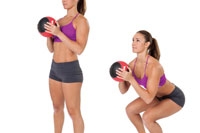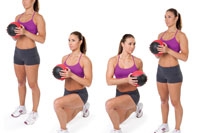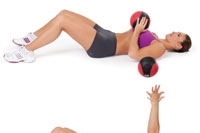
Adding a weighted medicine ball to your exercise routine adds some fun variety to your workout.
Push, pull, press, squat—all essential movements in a workout routine. But if you’re getting bored doing these movements on machines or with free weights, maybe it’s time to change your routine. Adding a weighted ball to your workout can deliver a fun challenge to an otherwise mundane exercise routine.
The boredom factor
If you become too accustomed to your exercise routine, over time you may grow bored and stop working out altogether.
Exercise scientists at the University of Florida found this to be true when they studied 114 men and women whose types of exercise either varied between workouts or stayed the same during each workout. Those who changed their workouts every two weeks over the eight-week study period enjoyed their workouts more. They were also less likely to drop out of their exercise programs than individuals who followed the same workout regimens week after week.
Doing the same exercise program with the same machines, weights, and movement patterns can also result in less improvement in physical fitness, an ironic outcome if this was your goal in engaging in a fitness program.
Machines are great, and definitely have their place in the gym; as a personal trainer, I use them with clients all the time. However, workouts can get stale and uninspiring after months of doing the same exercises on machines. It’s important to vary your program by adding different modalities, such as a medicine ball.
What is a medicine ball?
You may have seen medicine balls in the gym or in group classes; personal trainers regularly use them with their clients. So what is that ball you might see sitting in the corner, and how does it work?
Medicine balls have been a part of fitness since before the days of President Hoover; he helped craft a game, ultimately called “Hoover-ball,” using a 6 lb (2.7 kg) medicine ball that players tossed over a volleyball net.
Available in different sizes and weights, medicine balls are used to add variable resistance to your exercise program. Toss it, smash it, twist it, or press it; these balls go in all directions and apply forces in a way that is unique to them.
Why use it?
Medicine balls not only add variety to your workout, but also are very easy to use and relatively inexpensive. According to the American Council of Sports Medicine (ACSM), adding a medicine ball to a workout regimen can improve muscular power, endurance, and functional fitness as well as flexibility.
Safety first
Since medicine ball training is meant to be done with the greatest speed and power possible, it’s important to maintain excellent form. Many exercises using medicine balls are plyometric, meaning there is repeated and rapid stretching and contraction of the muscles in order to increase muscular power.
These exercises should be used as part of a lighter workout. If you go too hard, you may get overtired and lose your form.
You can also “throw” a few of these exercises in at the beginning of a regular workout, as long as the other exercises don’t require immense energy. This will prevent fatigue from the other exercises adversely affecting your technique and power development while using the medicine ball.
Exercises
For each exercise, aim for 2 to 3 sets of 10.
Squats

Ball: medium, handles are optional
- Holding the medicine ball in your hands, place your feet just wider than hip width.
- Hold the ball in front of your chest as you sit back toward your heels.
- Slowly stand back up.
- Repeat.
Walking lunge with twist

Ball: medium, handles are optional
- Hold the medicine ball in your hands and place one foot behind you, bending both knees.
- Step forward with your back foot and, as you step down, twist your torso to the opposite side, holding the medicine ball at chest height.
- Repeat on the other side.
Throw downs

Ball: large, rubber or nylon
- Holding the medicine ball over your head with both hands, engage your core and throw the ball down hard, pulling in at your hips.
- Pick it up and repeat.
Chops

Ball: medium, handles are optional
- Stand with your feet wider than hip-width apart, holding the ball in both hands behind and above your right ear.
- Push all of your weight into the left foot and with your heel raised, move the ball diagonally down across your body.
- Hinge at your hip, keeping your abs contracted and back straight, bending your knees.
- Repeat 10 times and then switch sides.
V sit-ups

Ball: small to medium, leather or nylon
- Lie on your back with your feet facing the ceiling and knees bent, holding the ball above and behind your head.
- Tightly contract your abs and lift your shoulders and head up, bringing your arms toward your feet.
- Slowly release back.
- Repeat.
Push-ups

Ball: smaller size, rubber
- Get into push-up (plank) position with your hands shoulder-width apart on the floor and your feet on the floor behind you.
- With the medicine ball under one hand, do a push-up.
- Roll the ball to the other hand and do another push-up.
- Repeat.
Chest press with toss

Ball: small to medium, rubber
- Lying on your back with your knees bent, hold the medicine ball over your chest.
- Push your hands straight up over your chest, toss the ball up, and catch it, bringing your arms back down to starting position.
- Repeat.
Sit-ups with ball toss

Ball: small to medium, rubber
- Lying on your back, hold the ball above your chest.
- As you sit up, toss the ball straight up in the air above you and catch it as you bring your torso back to the floor.
- Repeat.
Medicine ball bridge

Ball: medium to large, leather or nylon
- Lying on your back with your knees bent and your arms by your sides, place your heels on top of the medicine ball.
- Dig your heels in and lift your bum off the floor, squeezing your gluteals.
- Slowly lower your hips back down.
- Repeat.
Medicine ball exercises are a great complement to your strength training routine. By adding some throws, twists, and chops, you can work all angles of your body to take your workout to the next level.
Choosing your ball
The ACSM recommends that people start out with a lighter ball and work their way up to a heavier one as they get stronger. If you are training for sports-specific movements, you will want to mimic the movements with weights that are similar. Start with a lighter ball and work your way up as you get stronger.
For speed
- smaller
- lighter
For strength and power training
- heavier
- larger
For bouncing activities
- rubber
Throwing and catching
- leather or nylon
- easy to grip
- not too small




